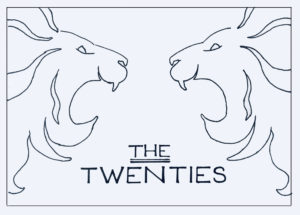
Illustration by Melissa Waddle
A century ago, the Roaring 20s ushered in an era of innovation, prosperity, cultural and societal change. These movements were not a choreographed affair, heading neatly in one direction. They surged this way and that, pushing against the boundaries of how life had been before the First World War. At the Non-GMO Project, we welcome the new decade with optimism, with the belief that diversity of thought and purpose can shake us loose from an agricultural system born of the Second World War. With that in mind, let’s start with the basics.
Part One - to read Part Two Click here.
Producing GMOs
The vast majority of the GMO crops grown in North America are grown for animal feed or biofuel, with some crops undergoing processing for convenience-ready foods. As such, you’d think the grocery store produce section was relatively safe territory, GMO-wise. But there’s a growing movement to employ new genetic engineering techniques to extend the shelf life and portability of some of the basics, like apples, lettuce and potatoes. Proponents of new GMOs reference problems such as food waste and food deserts — two very real and serious issues — to justify the modification of staple foods. But are GMOs the best solutions?
At the Non-GMO Project, we say, unsurprisingly, “no.” Does food that is deliberately engineered for longevity really qualify as “fresh” anymore? At best this is one of those “solutions” that appears to address a problem but really swaps out one problem for another. (Variety can be nice, but not so much when it comes to problems, and current wisdom is there are already more than enough of the latter to keep us from getting bored.)
Crisp, not CRISPR
Last October, I went to my local Fall Fruit Festival. Several hundred of my neighbors and I lined up to sample slivers of the most diverse and delectable apples, pears and grapes imaginable. Before that day, I’d never realized how limited my vocabulary was when it came to apples. I like a nice Gala, and I have some recipes that call for a good lookin’ and sweet cookin’ Granny Smith. The Festival introduced me to more varieties, textures, purposes and flavor profiles than I have adjectives for. And the grapes! The grapes were so delicious, I’d mud-wrestle a yellowjacket for a bunch all to myself. Which is precisely why produce that is genetically engineering for shelf life really gets my goat. There are whole galaxies of tastes out there! The delicacy of a ripe pear is part of what makes it special. And many apple varieties store and travel exceptionally well.
That magic is lost with new GMO creations like the Arctic non-browning apples. Genetic modification favors uniformity over variety, shelf life over taste. The samples at the Fall Fruit Festival were the product of generations of breeding, expert cultivation and devoted soil stewardship. Nature, thankfully, prefers diversity, giving us an apple for every occasion. If slicing an apple ahead of time and not having it brown is a priority for you, go with the Opal apple, bred using traditional methods for that trait.
It’s Not Easy Being Greens
For most of my life, I was not excited about greens. I blame negative childhood experiences, wading reluctantly through too many iceberg lettuce salads. Not until I started hanging out with farmers did I learn that “greens” weren’t synonymous with lack-luster lettuce — there were brassicas, chards, and spicy mustard greens, sweet spinach and beet greens. How these crops tasted when they were fresh, truly fresh, was worlds away from the glorified tissue-paper-veggies of my youth. I became a devoted fan of one particular farmer’s work, a housemate of mine who grew vegetables in schoolyards. (*Aspirational note: Farmers should have fans. Roadies, even. Their contributions are unique, powerful, and infinitely superior when experienced live). I ordered her wares in advance, picking up a box each week during the summer. One evening in early June, when the days were still long and cool, I received the most tender, colorful, flavorful kale I’d ever seen. This kale had been picked a few hours previously, then washed and bound into an elegant green-and-purple bouquet. I tucked the rest of my bounty into a tote bag and walked home, nibbling on the kale as I went, looking to all the world like a poorly dressed bride who’d gotten a bit peckish on her way up the aisle.
Learning to appreciate vegetables so late in life made me a little sad for all the wasted years and missed flavors. Learning there’s GMO Romaine lettuce — engineered for longer shelf life — only made that feeling worse. This takes us in entirely the wrong direction! Genetically modifying lettuce for longer shelf life doesn’t make vegetables more accessible, it makes more people hate vegetables. Greens are like bread: they deteriorate from peak perfection by the hour, and tasting the truly fresh can change your whole world view. Travel, storage and delivery times cost dearly in terms of flavor, texture, and nutrient value. Harnessing the ability to deliver limp, lifeless and nutrient-depleted Romaine across space and time benefits no one.
In Praise of Farmers
Unequal access to fresh produce is a huge problem, as is food waste. Then there’s that uniquely western phenomenon of nutrient deficiency and obesity occurring side-by-side. But what if we took all the time and money that goes into engineering an immortal lettuce leaf and put it towards supporting local food growers? If instead of driving the color out of our apples, we put that expertise toward rebuilding biodiversity?
Applying GMO solutions to systemic problems only addresses the tip of the iceberg lettuce. It doesn’t touch root causes. For that, we need to: grow and buy local; value and compensate the contributions made by our hard-working farmers; and treasure the diversity and brilliance of the seeds they steward for our benefit.
